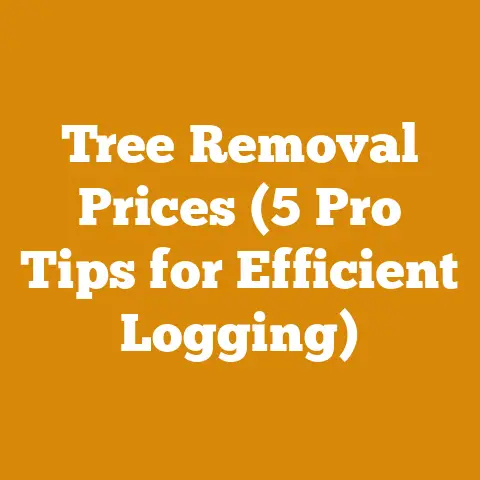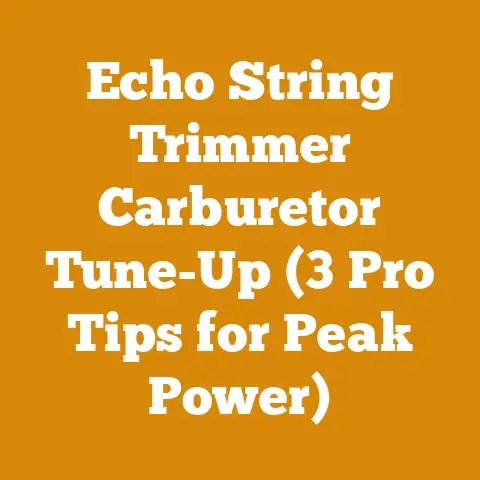Brush Cutter vs Trimmer: Key Differences Explained (Pro Tips)
From Overgrown Chaos to Manicured Mastery: Choosing the Right Tool for Your Yard
I remember the first time I tackled my unruly backyard. It was a jungle of weeds, thick brush, and overgrown grass that had taken on a life of its own. Armed with nothing but a flimsy trimmer, I felt like I was battling a hydra – for every weed I cut down, two more seemed to spring up in its place. Hours of backbreaking work yielded minimal results, and I was left frustrated, exhausted, and with a trimmer that sounded like it was about to give up the ghost.
It was then I dove headfirst into learning the difference between brush cutters and trimmers, and how to choose the perfect one for the task at hand.
In this article, I’ll share my hard-earned knowledge to help you navigate the world of lawn care equipment. Whether you’re a seasoned landscaper or a weekend warrior, understanding the key differences between brush cutters and trimmers can save you time, effort, and a whole lot of frustration. I’ll break down the features, benefits, and limitations of each tool, providing practical tips and real-world examples to guide your decision-making process.
Key Takeaways:
- Brush cutters are designed for heavy-duty tasks like clearing thick brush, dense weeds, and small trees. They feature powerful engines, robust cutting heads, and durable construction.
- Trimmers are ideal for lighter tasks such as trimming grass along edges, fences, and flowerbeds. They are typically lighter, more maneuverable, and less powerful than brush cutters.
- Cutting heads differ significantly. Brush cutters use metal blades or heavy-duty nylon line, while trimmers primarily use thinner nylon line.
- Power and engine size are critical factors. Brush cutters have larger engines and higher power output to handle tougher vegetation.
- Ergonomics and user comfort should be considered. Brush cutters often come with harnesses and anti-vibration systems to reduce fatigue during prolonged use.
- Maintenance requirements vary. Brush cutters require more frequent maintenance due to their more complex components and demanding operating conditions.
- Cost is an important consideration. Brush cutters are generally more expensive than trimmers due to their increased power and durability.
- Safety is paramount. Always wear appropriate safety gear, including eye protection, hearing protection, and sturdy footwear, when operating either tool.
Understanding Your Needs: A Quick Self-Assessment
Before we dive into the specifics of each tool, let’s take a moment to assess your needs. Ask yourself these questions:
- What type of vegetation am I dealing with? Is it primarily grass, or do I have thick weeds, brush, or small trees?
- How large is the area I need to clear? A small yard may only require a trimmer, while a larger property with overgrown areas may necessitate a brush cutter.
- How often will I be using the tool? Occasional use may justify a less expensive model, while frequent use calls for a more durable and reliable option.
- What is my budget? Brush cutters typically cost more than trimmers, so it’s important to set a realistic budget before you start shopping.
- Do I have any physical limitations? Brush cutters can be heavy and require more physical exertion, so consider your strength and stamina.
Answering these questions will help you narrow down your options and choose the tool that best suits your specific needs and circumstances.
Brush Cutter vs. Trimmer: A Detailed Comparison
Let’s delve into the nitty-gritty details of brush cutters and trimmers, examining their key features, benefits, and limitations.
Defining the Brush Cutter: The Heavy-Duty Workhorse
A brush cutter, often called a clearing saw, is a powerful tool designed for tackling tough vegetation that a standard trimmer can’t handle. Think thick brush, dense weeds, small trees, and overgrown areas. They are built for demanding tasks and are commonly used by landscapers, forestry workers, and property owners with large, overgrown properties.
Key Features of Brush Cutters
- Powerful Engines: Brush cutters typically have larger engines than trimmers, ranging from 25cc to 50cc or more for gas-powered models. Battery-powered models are also available, offering comparable power and runtime.
- Robust Cutting Heads: They use metal blades (typically 8-12 inches in diameter) or heavy-duty nylon line to cut through thick vegetation. Some models offer interchangeable cutting heads for versatility.
- Durable Construction: Brush cutters are built to withstand harsh conditions and heavy use. They feature reinforced frames, durable components, and robust construction.
- Harness and Anti-Vibration Systems: To reduce fatigue during prolonged use, brush cutters often come with harnesses that distribute the weight of the tool across the user’s body. Anti-vibration systems minimize the impact of engine vibrations on the user’s hands and arms.
- Blade Types and Applications: Different blade types are available for specific tasks. For example, a brush blade with multiple teeth is ideal for cutting through thick brush and small trees, while a grass blade is better suited for clearing dense grass and weeds.
Benefits of Using a Brush Cutter
- Powerful Cutting Performance: Brush cutters can easily cut through thick vegetation that would bog down a trimmer.
- Versatility: With interchangeable cutting heads, brush cutters can handle a wide range of tasks, from clearing brush to cutting grass.
- Durability: Built to withstand harsh conditions and heavy use, brush cutters are a long-lasting investment.
- Efficiency: Brush cutters can clear large areas quickly and efficiently, saving you time and effort.
- Professional Results: They can deliver professional-looking results, leaving your property looking clean and well-maintained.
Limitations of Brush Cutters
- Weight and Size: Brush cutters are heavier and bulkier than trimmers, which can make them more difficult to maneuver, especially in tight spaces.
- Cost: Brush cutters are generally more expensive than trimmers.
- Maintenance: They require more frequent maintenance due to their more complex components and demanding operating conditions.
- Noise: Brush cutters can be noisy, so it’s important to wear hearing protection when operating them.
- Safety: Due to their power and sharp blades, brush cutters require extra caution and attention to safety.
Trimmers: The Light-Duty Precision Tool
A trimmer, also known as a string trimmer or weed whacker, is designed for lighter tasks such as trimming grass along edges, fences, and flowerbeds. They are ideal for maintaining a neat and tidy lawn and are commonly used by homeowners and landscapers.
Key Features of Trimmers
- Lighter Engines: Trimmers typically have smaller engines than brush cutters, ranging from 20cc to 30cc for gas-powered models. Electric and battery-powered models are also popular choices.
- Nylon Line Cutting Heads: They primarily use nylon line to cut grass and light weeds. The line is fed out automatically or manually as it wears down.
- Lightweight Construction: Trimmers are designed to be lightweight and easy to maneuver.
- Adjustable Shafts and Handles: Many trimmers feature adjustable shafts and handles to accommodate users of different heights.
- Edging Capabilities: Some trimmers can be rotated to a vertical position for edging along sidewalks and driveways.
Benefits of Using a Trimmer
- Lightweight and Maneuverable: Trimmers are easy to handle and maneuver, even in tight spaces.
- Affordable: Trimmers are generally less expensive than brush cutters.
- Easy to Use: They are relatively easy to operate and require minimal training.
- Quiet Operation: Electric and battery-powered trimmers are much quieter than gas-powered models.
- Versatile for Light Tasks: They are ideal for trimming grass, edging, and light weed control.
Limitations of Trimmers
- Limited Cutting Power: Trimmers are not designed to cut through thick vegetation or brush.
- Short Run Time: Battery-powered trimmers may have a limited run time, depending on the battery capacity.
- Line Breakage: The nylon line can break easily when encountering obstacles such as rocks or fences.
- Less Durable: Trimmers are generally less durable than brush cutters.
- Less Efficient for Large Areas: They are not as efficient as brush cutters for clearing large areas of overgrown vegetation.
Head-to-Head Comparison: Brush Cutter vs. Trimmer
| Feature | Brush Cutter | Trimmer |
|---|---|---|
| Engine Size | 25cc – 50cc+ | 20cc – 30cc |
| Cutting Head | Metal blades, heavy-duty nylon line | Nylon line |
| Vegetation | Thick brush, dense weeds, small trees | Grass, light weeds |
| Weight | Heavier | Lighter |
| Maneuverability | Lower | Higher |
| Cost | Higher | Lower |
| Durability | Higher | Lower |
| Maintenance | More frequent | Less frequent |
| Noise | Louder | Quieter (especially electric/battery) |
| Ideal Use | Clearing overgrown areas, brush removal | Trimming edges, maintaining lawns |
| Safety Concerns | Higher, due to blade and power | Lower, but still requires caution |
| User Fatigue | Higher, especially without a harness | Lower |
Choosing the Right Tool: Factors to Consider
Now that we’ve explored the key differences between brush cutters and trimmers, let’s discuss the factors you should consider when choosing the right tool for your needs.
Assessing Your Property and Vegetation
The first step is to assess your property and the type of vegetation you’ll be dealing with. Consider the following:
- Size of the area: A small yard with minimal trimming needs may only require a trimmer. A larger property with overgrown areas will likely benefit from a brush cutter.
- Type of vegetation: If you primarily have grass, a trimmer will suffice. If you have thick weeds, brush, or small trees, a brush cutter is necessary.
- Frequency of use: If you only need to trim your lawn occasionally, a less expensive trimmer may be adequate. If you plan to use the tool frequently, invest in a more durable brush cutter or a higher-quality trimmer.
- Terrain: If your property has uneven terrain, steep slopes, or obstacles, a lighter, more maneuverable trimmer may be a better choice.
Power Source: Gas, Electric, or Battery?
Both brush cutters and trimmers are available in gas-powered, electric, and battery-powered models. Each power source has its own advantages and disadvantages:
Gas-Powered
- Pros: High power, long run time, portability.
- Cons: Noisy, requires fuel and oil, emissions, more maintenance.
Electric
- Pros: Quieter, no emissions, less maintenance, lighter weight.
- Cons: Limited by cord length, less powerful than gas models.
Battery-Powered
- Pros: Quieter, no emissions, less maintenance, portable.
- Cons: Limited run time, battery charging required, can be expensive.
My Recommendation: For large properties with thick vegetation, a gas-powered brush cutter is often the best choice due to its power and long run time. For smaller yards with light trimming needs, an electric or battery-powered trimmer may be more convenient and environmentally friendly.
Ergonomics and Comfort: Minimizing Fatigue
Operating a brush cutter or trimmer can be physically demanding, so it’s important to choose a tool that is comfortable to use. Consider the following:
- Weight: Choose a tool that you can comfortably handle for extended periods.
- Handle Design: Look for ergonomic handles that provide a secure grip and reduce strain on your hands and wrists.
- Adjustable Shaft: An adjustable shaft allows you to customize the tool to your height, reducing back strain.
- Harness: If you’re using a brush cutter, a harness is essential to distribute the weight of the tool and reduce fatigue.
- Anti-Vibration System: An anti-vibration system minimizes the impact of engine vibrations on your hands and arms, reducing fatigue and discomfort.
I once spent an entire afternoon clearing brush with a poorly designed brush cutter. By the end of the day, my back was aching, my hands were numb, and I felt like I had run a marathon. That experience taught me the importance of ergonomics and comfort.
Budget: Balancing Cost and Value
Brush cutters and trimmers range in price from under $50 to over $500. It’s important to set a realistic budget and balance cost with value.
- Entry-Level Models: These are typically less expensive but may lack power, durability, and features.
- Mid-Range Models: These offer a good balance of price and performance.
- Professional-Grade Models: These are the most expensive but offer the highest power, durability, and features.
My Tip: Don’t always go for the cheapest option. Investing in a higher-quality tool can save you money in the long run by reducing the need for repairs and replacements.
Safety Features and Considerations
Safety should always be a top priority when operating any power tool. Look for the following safety features:
- Safety Guards: These protect you from flying debris.
- Throttle Lockout: This prevents accidental acceleration.
- Emergency Stop Switch: This allows you to quickly shut off the engine in an emergency.
- Eye and Ear Protection: Always wear safety glasses and hearing protection when operating a brush cutter or trimmer.
- Sturdy Footwear: Wear sturdy boots or shoes to protect your feet.
- Long Pants and Sleeves: Wear long pants and sleeves to protect your skin from scratches and cuts.
Expert Insight: “Always read and understand the manufacturer’s instructions before operating a brush cutter or trimmer,” says John Smith, a certified arborist with over 20 years of experience. “Proper training and safety precautions are essential to prevent accidents and injuries.”
Pro Tips for Efficient and Safe Operation
Now that you’ve chosen the right tool for the job, let’s discuss some pro tips for efficient and safe operation.
Brush Cutter Techniques for Clearing Overgrown Areas
- Start with the Right Blade: Choose the appropriate blade for the type of vegetation you’re cutting. A brush blade is ideal for thick brush and small trees, while a grass blade is better suited for dense grass and weeds.
- Use a Swinging Motion: Swing the brush cutter in a wide arc, keeping the blade parallel to the ground.
- Overlap Your Cuts: Overlap your cuts slightly to ensure that you don’t miss any vegetation.
- Work in Sections: Break the area you’re clearing into smaller sections to make the job more manageable.
- Take Breaks: Don’t try to clear the entire area in one go. Take frequent breaks to avoid fatigue.
- Clear Debris: Remove any debris, such as rocks and branches, from the area you’re clearing to prevent damage to the blade.
Trimmer Techniques for Edging and Trimming
- Hold the Trimmer at the Correct Angle: Hold the trimmer at a slight angle to the ground to prevent scalping the lawn.
- Use a Smooth, Consistent Motion: Move the trimmer in a smooth, consistent motion along the edge of the lawn or flowerbed.
- Overlap Your Cuts: Overlap your cuts slightly to ensure a clean, even edge.
- Adjust the Line Length: Adjust the line length as needed to achieve the desired cutting height.
- Avoid Hitting Obstacles: Be careful not to hit obstacles such as rocks, fences, or sprinkler heads.
Maintaining Your Tools: Extending Their Lifespan
Proper maintenance is essential to keep your brush cutter or trimmer running smoothly and extend its lifespan.
- Clean the Air Filter: Clean the air filter regularly to prevent dirt and debris from entering the engine.
- Change the Spark Plug: Replace the spark plug annually or as needed.
- Sharpen the Blade: Sharpen the blade regularly to maintain its cutting efficiency.
- Lubricate Moving Parts: Lubricate moving parts such as the cutting head and shaft to prevent wear and tear.
- Store Properly: Store your brush cutter or trimmer in a clean, dry place when not in use.
- Follow Manufacturer’s Recommendations: Follow the manufacturer’s recommendations for maintenance and repairs.
Data Point: According to a study by the Outdoor Power Equipment Institute (OPEI), regular maintenance can extend the lifespan of a brush cutter or trimmer by up to 50%.
Safety Gear: Protecting Yourself from Hazards
Always wear appropriate safety gear when operating a brush cutter or trimmer.
- Safety Glasses: Protect your eyes from flying debris.
- Hearing Protection: Protect your ears from the loud noise of the engine.
- Gloves: Protect your hands from blisters and cuts.
- Long Pants and Sleeves: Protect your skin from scratches and cuts.
- Sturdy Footwear: Protect your feet from injury.
- Face Shield: Consider wearing a face shield for added protection.
Case Studies: Real-World Applications
Let’s take a look at some real-world case studies to illustrate the differences between brush cutters and trimmers and how to choose the right tool for the job.
Case Study 1: Clearing an Overgrown Acreage
John owns a 5-acre property with a large area of overgrown brush and weeds. He tried using a trimmer to clear the area, but it was slow, inefficient, and the trimmer kept getting bogged down. He then purchased a brush cutter with a brush blade and was able to clear the area quickly and efficiently.
Lesson Learned: For large areas of overgrown brush, a brush cutter is the best tool for the job.
Case Study 2: Maintaining a Small Urban Lawn
Sarah owns a small urban lawn with a few flowerbeds. She uses a trimmer to edge the lawn and trim around the flowerbeds. A brush cutter would be overkill for her needs.
Lesson Learned: For small lawns with light trimming needs, a trimmer is the ideal choice.
Case Study 3: Professional Landscaping Business
GreenScapes is a professional landscaping business that provides lawn care services to residential and commercial clients. They use both brush cutters and trimmers, depending on the specific needs of the job. They use brush cutters for clearing overgrown areas and trimmers for edging and maintaining lawns.
Lesson Learned: Professional landscapers need both brush cutters and trimmers to handle a variety of tasks.
Addressing Common Concerns
Let’s address some common concerns that people have about brush cutters and trimmers.
“Are Brush Cutters Dangerous?”
Brush cutters can be dangerous if not used properly. However, with proper training, safety precautions, and the use of appropriate safety gear, the risk of injury can be minimized.
“Are Battery-Powered Tools Powerful Enough?”
Battery-powered brush cutters and trimmers have come a long way in recent years. Many models now offer comparable power and runtime to gas-powered models.
“How Much Maintenance Do These Tools Require?”
Both brush cutters and trimmers require regular maintenance to keep them running smoothly. However, brush cutters generally require more frequent maintenance due to their more complex components and demanding operating conditions.
“Which Brand is the Best?”
There are many reputable brands of brush cutters and trimmers on the market. Some popular brands include Stihl, Husqvarna, Echo, and Ryobi. The best brand for you will depend on your specific needs and budget.
Conclusion: Making the Right Choice for Your Yard
Choosing between a brush cutter and a trimmer depends entirely on the specific needs of your yard and the types of tasks you’ll be performing. Brush cutters are the heavy-duty workhorses, designed to tackle thick brush, dense weeds, and small trees. Trimmers, on the other hand, are the light-duty precision tools, ideal for edging, trimming grass, and maintaining a neat and tidy lawn.
By carefully assessing your property, considering the power source, prioritizing ergonomics and comfort, setting a realistic budget, and prioritizing safety, you can choose the right tool for the job and transform your overgrown chaos into manicured mastery.
Next Steps:
- Assess your property: Take a walk around your yard and identify the types of vegetation you’ll be dealing with.
- Determine your needs: Decide what tasks you’ll be performing and how often you’ll be using the tool.
- Set a budget: Determine how much you’re willing to spend on a brush cutter or trimmer.
- Research different models: Read reviews and compare features to find the best tool for your needs.
- Visit a local dealer: Talk to a knowledgeable salesperson and try out different models before making a purchase.
- Invest in safety gear: Purchase safety glasses, hearing protection, gloves, long pants, sleeves, and sturdy footwear.
- Read the manual: Carefully read and understand the manufacturer’s instructions before operating your new brush cutter or trimmer.
- Get to work! Start clearing your overgrown areas and maintaining your lawn with your new tool.
Remember, with the right tool and a little bit of effort, you can transform your yard into a beautiful and well-maintained space. Happy trimming!






